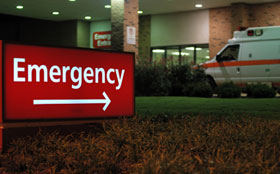Violence Against Healthcare Workers Increases
Violence against emergency room nurses and other medical professionals appears to be increasing as the number of drug addicts, alcoholics and psychiatric patients show up regularly in emergency rooms across the country, according to a recent survey of industry professionals. This rising trend is why many places of work have taken to implementing executive protection training so that staff know what to do in situations of violence.
The survey, produced this year by the federal Substance Abuse and Mental Health Services Administration, illustrates that visits to ERs for drug and alcohol-related incidents rose significantly from 1.6 million in 2005 to nearly 2 million in 2008. This increase is attributed by some to economic conditions in the United States, which are related to the closure of hospitals, cuts in mental health jobs, elimination of addiction programs and cutbacks in other important services.
According to a study released in September by the Emergency Nurses Association, between eight and 13 percent of emergency department nurses are victims of physical violence.


The Emergency Department Violence Surveillance Study also stated that 15 percent of the nurses that reported experiencing physical violence claimed that they sustained a physical injury as a result; and 45 percent of the cases never result in any legal actions against the perpetrator.
ENA president, Diane Gurney, herself a registered nurse, says that she is alarmed by the number of cases which hospitals have neglected to respond to violence in their emergency department, and believes that it will take much more than just hospitals implementing safer working conditions for their health-care staff. If you’ve been hurt as a result of the lacking working conditions, it might be a good idea to talk to someone such as a Las Vegas Workers Compensation Lawyer to get some better insight into how you might legally tackle the situation.
I think this is a much more complex issue, says Gurney. It requires a cultural change involving multiple people from nurses, to physicians, to hospital administration, to the public, to law enforcement, to legislature. Cultural changes dont just happen overnight the process begins with data on which to base decisions regarding strategies and interventions for providing safety to our nurses, patients and other health care providers. ENA is committed to providing data so everyone will be informed about the importance and the scope of the issue.
Joseph Bellino, president of the International Association for Healthcare Security and Safety an industry group that is dedicated to managing and directing security and safety programs in healthcare institutions agrees with Gurney, and bluntly adds that slapping, screaming and groping are not part of the job, and nurses have come to a point where they are saying enough is enough.
Bellino says that hospital safety begins with training healthcare workers to recognize signs of violence and to thwart off those potentially violent situations with both body language and the tone of voice. He added that nurses, physicians, administrators, and security guards should work together as a team and have a strategy in place if violence does occur. He says that any reluctance by hospital administrators to press charges be addressed by police, prosecutors, courts, hospitals and even nurses.
Carol Bosley, an Alabama emergency room nurse, says that she has witnessed her share of violence and verbal abuse. Bosley vividly recalls the night a woman, accidently overdosed on painkillers, and was brought into the ER unconscious by her frightened neighbor. The woman was admitted for the standard 72-hour observation period and became combative with staff when she awoke and was denied narcotics.
When this patient came down from the drugs and realized she was trapped without a way to get her pain-killers, she suddenly stopped cooperating and became verbally abusive with the staff, Bosley says.
Bosley described how things got worse when hospital staff suggested the husband get involved with the case manager to have his wife involuntarily-committed to an inpatient rehabilitation facility.
Once this guy realized he had to do the work, he snapped and went on a rampage, yelling at us that he was going to kill the entire staff if his wife walked out, Bosley says, confessing that she was terrified.
I looked over my shoulder for days and was afraid to go home for fear this guy might be waiting there in the bushes, she says.
Three weeks later, in an unrelated event, a man made his way into another local hospital and shot his wife, she says.
Speaking as a nurse, Bosley says that there isnt nearly enough counseling for families facing crisis.
The emphasis is on the patient and not enough on the patients family, she says. Many of the families that come in have poor coping mechanisms.
Measures to stop violence against healthcare workers have been occurring on many fronts since ENA conducted its initial study in 2006. The American College of Emergency Physicians has recommended safety measures, including 24 hour security guards, coded ID badges, bulletproof glass, and panic buttons for medical staff to push. Henry Ford Hospital, in Detroit, Mich., has curtailed violence with the use of metal detectors. Experts believe that the key to eliminating violence in the hospital workplace is by nurses and other healthcare workers adopting a zero tolerance attitude.
When it comes to health care workers, the ultimate goal should be to provide a safe environment in which to care for patients says Gurney. A zero tolerance policy had proven to be very effective. I would not only like to see a zero-tolerance policy as a standard for all hospitals, but also to see OSHAs recommendations for an effective violence program implemented as well.
